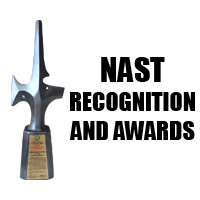NAST PHL goes to Rizal
- Details
Committed to the promotion of science and technology to the public, the Philippine Science Heritage Center brought the Meet Your Scientist program in Raises Academy, Angono, Rizal on February 06, 2015. More than 200 students and teachers attended the discussion about the different careers in science— physics and photonics, mathematics, and environmental science.
The experts who shared their experiences in their chosen field were Outstanding Young Scientists, Dr. Raphael Guerrero, professor at the Department of Physics, Ateneo de Manila University; Engr. Glenn Banaguas, professor at the De La Salle Araneta University; and Dr. Richard Lemence, professor at the Institute of Mathematics, University of the Philippines Diliman.
Also present to discuss the different scholarships DOST offers to students who would like to take a degree related to science and technology is Ms. Daisy Demoni, supervising science research specialist at DOST Science Education Institute.
PSHC will be holding monthly Meet Your Scientist this year. With this activity, the Academy hopes to help discover and unleash the science in the younger generations.
The PSHC is being managed and maintained by the National Academy of Science and Technology (NAST Philippines) as mandated by RA 9107. NAST Philippines is the country’s recognition and advisory body on matters related to science.
NAST PHL focuses on Environmental Chemical Pollutants and NCDs
- Details
The Roundtable Discussion (RTD) on Environmental Chemical Pollutants and Non-Communicable Diseases (NCDs) was organized by the National Academy of Science and Technology, Philippines (NAST PHL) through its Mathematical and Physical Sciences Division (MPSD) on February 24, 2015 at Hotel Jen Manila.
The RTD discussed environmental chemical pollutants and their effects on health, and suggested ways on how to address the problems through identification of research gaps and policy recommendations.
Invited experts were Dr. Evangeline C. Santiago, head, Research and Analytical Services Laboratory, Natural Sciences Research Institute, University of the Philippines (UP) Diliman; Dr. Catherine Lynn T. Silao, head, Molecular Genetics Laboratory, Institute of Human Genetics, National Institutes of Health, UP Manila; Dr. Emmanuel S. Baja, research associate professor of environmental epidemiology, Institute of Clinical Epidemiology, National Institutes of Health, UP Manila and visiting scientist, Department of Environmental Health, Harvard School of Public Health; and Dr. Eva S. Ocfemia, assistant director, Environmental Management Bureau, Department of Natural Resources and Environment (DENR-EMB).
Dr. Santiago discussed the results of their monitoring of organic pollutants in river and coastal areas such as nonylphenol, bisphenol A (BPA), and persistent organic pollutants (POPs). According to Dr. Santiago, nonylphenol can be found in industrial detergents while BPA is commonly found in plastic containers, both of which are highly toxic to fish and humans. Moreover, POPs commonly found in pesticides were detected in river sediments and exposure to these produces various negative effects on body processes.
Consumption of contaminated fish and shellfish increases the exposure of humans to these pollutants. She further suggested monitoring of toxic organic pollutants in air, water, and food to manage the risk of population to the adverse health effects of these chemicals.
NAST PHL discusses Molecular Pathogenesis of Infectious Diseases in partnership with the UP Manila and Case Western Reserve University
- Details
The National Academy of Science and Technology, Philippines (NAST PHL), in partnership with the University of the Philippines Manila and Case Western Reserve University of Cleveland, Ohio, through its Health Sciences Division conducted the Roundtable Discussion on Molecular Pathogenesis of Infectious Diseases on February 20, 2015 at Hotel Jen Manila.
The RTD, organized by the Health Sciences Division chaired by Acd. Jaime C. Montoya, along with Dr. Edsel Maurice T. Salvana, NAST Outstanding Young Scientist and Director of the Institute of Molecular Biology and Biotechnology at the National Institutes of Health as thefocal person, aimed to (1) learn about the molecular pathogenesis of infectious diseases and how these mechanisms lead to manifestation of infections; (2) understand the molecular mechanisms of infection in order to determine possible treatment strategies to minimize morbidity and mortality; and (3) understand disease interactions at the molecular level and how these affect pathogenicity and disease outcomes.
Acd. William G. Padolina, president of NAST PHL, welcomed the speakers and participants to the RTD. He hoped that aside from the technical knowledge, the RTD will also serve as a venue for future research collaboration between the three institutions regarding infectious diseases. Acd. Carmencita D. Padilla, chancellor of the University of the Philippines (UP) Manila and member of the NAST Health Sciences Division, emphasized the value in prevention and preparedness in combating infectious diseases. She mentioned that UP Manila and the Philippine General Hospital (PGH) are investing heavily in the prevention and control of communicable diseases. As chancellor, she is also looking forward to having a formal collaboration with Case Western Reserve University. Such a collaboration will greatly help our institutions come up with evidence-based recommendations that can be used in the formulation of health policy in the Philippines.












